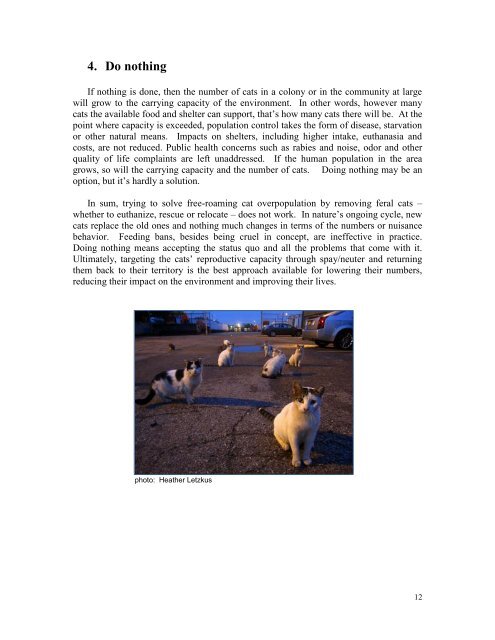- Page 1 and 2: TNR HandbookThe Guide to Trap-Neute
- Page 3 and 4: Table of ContentsForeword by Susan
- Page 5 and 6: Chapter Ten: The Neighborhood Cats
- Page 7 and 8: ForewordOne of the first ferals I e
- Page 9: Introduction“If we keep ‘em in
- Page 12 and 13: 2. What is Trap-Neuter-Return?Trap-
- Page 14 and 15: c) Fewer nuisance complaints. As me
- Page 17: and as their hunger grows, they wil
- Page 21 and 22: After you’ve determined how many
- Page 23 and 24: for this purpose. Once you can talk
- Page 25 and 26: like the board of a homeowners asso
- Page 27 and 28: information provided because of the
- Page 29 and 30: act to discourage cats from enterin
- Page 31 and 32: epel. It operates on four “C” b
- Page 33 and 34: • Free-standing fencesPurrfect Fe
- Page 35 and 36: • Type of feeding stationThe perf
- Page 37 and 38: Amazon (www.amazon.com) for “Le B
- Page 39 and 40: will be drawn to this easily reache
- Page 41 and 42: a search for “heated water bowl
- Page 43 and 44: interior warm enough to prevent or
- Page 45 and 46: food works best for your budget, th
- Page 47 and 48: steroids, tranquilizers, anesthetic
- Page 49: weather, loud construction work nea
- Page 52 and 53: • Feralvilla Outdoor Cat ShelterD
- Page 54 and 55: • Styrofoam boxesRestaurants and
- Page 56 and 57: Another option is the Snuggle Safe
- Page 58 and 59: apart. Knowing the correct number,
- Page 60 and 61: 4. Schedule the spay/neuterAfter yo
- Page 62 and 63: three more traps than the number of
- Page 64 and 65: Tomahawk Live Trap- Neighborhood Ca
- Page 66 and 67: 11 inches in height. In our opinion
- Page 68 and 69:
trap are attached. The transfer doo
- Page 70 and 71:
Feral cat densNeighborhood Cats Fer
- Page 72 and 73:
drop trap (code: KITDT) - see Figur
- Page 74 and 75:
That said, not every community offe
- Page 76 and 77:
practice. In our experience, there
- Page 78 and 79:
saving one day. Also remember, you
- Page 80 and 81:
intrusions you and others make into
- Page 82 and 83:
doing so. Don’t check too frequen
- Page 84 and 85:
Winter trappingSome trappers in nor
- Page 86 and 87:
around and inflict a severe bite or
- Page 88 and 89:
The bottle-and-string method is use
- Page 90 and 91:
you let her go right away, there is
- Page 92 and 93:
If you might have to care for unwea
- Page 94 and 95:
Unless a caretaker objects on relig
- Page 96 and 97:
Caddie” by Tomahawk (see Figure 9
- Page 98 and 99:
effective, some experienced trapper
- Page 100 and 101:
feet long, and lean it up against a
- Page 102 and 103:
sodium hypochlorite on the label of
- Page 104 and 105:
PreparationsAs with any trapping, i
- Page 106 and 107:
4. Anchor the trap. Place a heavy o
- Page 108 and 109:
transfer cage, so the far end needs
- Page 110 and 111:
11. Caring for Cats in TrapsWhile t
- Page 112 and 113:
Feeding and cleaningThe traps shoul
- Page 114 and 115:
7. Secure the rear doorAfter you’
- Page 116 and 117:
Figure 12-1 shows the Setup fullyas
- Page 118 and 119:
unlikely the cat would be able to o
- Page 120 and 121:
• Special instructionsAny special
- Page 122 and 123:
The FVRCP vaccine, also known as th
- Page 124 and 125:
difficult without the ability to te
- Page 126 and 127:
windpipe and cut off her breathing.
- Page 128 and 129:
“snap” test, it produces a resu
- Page 130 and 131:
In our experience, the primary caus
- Page 132 and 133:
Before releasing a spayed female, r
- Page 134 and 135:
has been created and one set of cat
- Page 136 and 137:
and water bowls - see the Feral Cat
- Page 138 and 139:
enforcement agency will tell you if
- Page 140 and 141:
long will show signs of being socia
- Page 142 and 143:
feral at all yet and may tame immed
- Page 144 and 145:
When they’re verycomfortable with
- Page 146 and 147:
socialize enough, which is very lik
- Page 148 and 149:
When the cat no longer uses the cag
- Page 150 and 151:
alternatives, like scratching posts
- Page 152 and 153:
• Where to lookIn order to attrac
- Page 154 and 155:
In case you’re unable to return t
- Page 156 and 157:
18. Feral Cat ResourcesBooks Implem
- Page 158 and 159:
Petco Foundation (4Rs Project Suppo
- Page 160 and 161:
ToolkitsAction Kit: Advocating for
- Page 162 and 163:
Appendix BHOW TO BUILDTHE NEIGHBORH
- Page 164 and 165:
5. Place piece E two inches back fr
- Page 166 and 167:
Trap LogProject/Colony: ___________
- Page 168:
In memory ofBobby Kergis1952 - 2011








